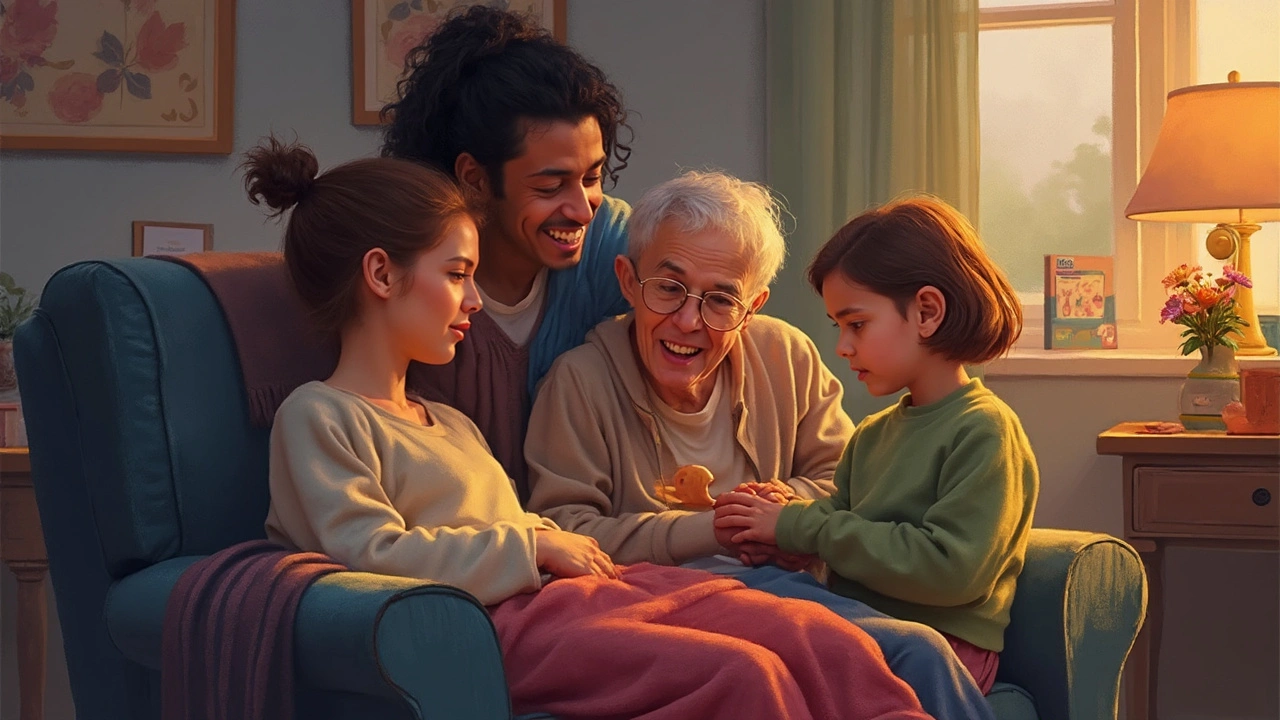Palliative Massage: A Healing Touch for the Soul

Palliative massage isn’t some mystical thing—it’s about using gentle touch to help people with serious illnesses feel less pain and more comfort. No fancy spa music needed. At its core, this is about easing symptoms, making the body feel a little lighter when everything else gets heavy.
It’s not only about muscles or knots. When you’re in hospice or coping with something chronic, your skin gets sensitive, your energy is unpredictable, and emotions run high. The right kind of touch can make a day a little more bearable. Studies show that even a simple hand or foot massage can lower anxiety and sometimes cut pain meds down a notch. No one expects a miracle, but sometimes the little things are the ones people remember most.
If you’re thinking about palliative massage for yourself or someone close, start simple. Ask what feels good. Does a warm cloth over the hands help? Would a back rub calm frazzled nerves? These small touches can make a regular Tuesday feel a lot less scary. Stick around—there’s more to this than you might think.
- What Palliative Massage Really Is
- The Impact of Touch on Pain and Stress
- Tips for Choosing a Good Therapist
- What Happens During a Session
- How Families Can Support the Experience
What Palliative Massage Really Is
Palliative massage is a type of touch therapy designed specifically for people with life-limiting illnesses. The goal isn’t to fix or cure. Instead, it’s about comfort, relief, and human connection. This isn’t your deep-tissue sports massage. Instead, the therapist uses light, careful movements to match what the client can handle. It’s all about helping folks feel just a bit better for a while, especially when days are tough.
Here’s a common myth: you need to be in a fancy hospice center to get palliative massage. Not true. These sessions happen anywhere—hospital beds, living rooms, or hospice facilities. What matters most is that the massage is personalized based on someone’s medical needs, what their body can handle, and their comfort level.
Some of the most common things people hope to get out of palliative massage include:
- Pain relief, especially when regular painkillers aren’t doing enough
- Less anxiety and a better mood
- Smoother sleep—many folks doze off during a session
- Help with swelling, especially in people resting in bed a lot
- Simply feeling seen and cared for as a person, not just a patient
The real power of palliative massage comes from how it’s tailored. For instance, a therapist might avoid certain areas affected by medical devices, treat sensitive skin gently, or focus on places that ache the most. It’s all about what’s safe and feels good, nothing more, nothing less.
If you’re wondering about proof, look at some numbers. A 2023 national hospice survey asked families about their loved ones’ care and reported noticeable benefits from massage, especially in lowered anxiety and more restful sleep.
| Benefit Reported | Percentage of Families That Noticed It |
|---|---|
| Reduced Anxiety | 82% |
| Better Sleep | 76% |
| Less Physical Pain | 69% |
At the heart of it, palliative massage is all about listening—both to what the body says and what the person needs. That’s where the magic happens, even if it’s just for a short while.
The Impact of Touch on Pain and Stress
Ever notice how a simple hug or hand squeeze calms you down on a rough day? There’s actually science behind it. Touch helps our bodies release oxytocin, the good-vibe hormone that makes us feel safe and connected. For people facing illness, that sense of connection is huge—it’s not just comfort, it’s real relief.
When you talk about palliative massage, most people think about easing pain—and with good reason. One study from the Journal of Pain and Symptom Management followed hospice patients getting regular gentle massage. The results? Pain scores dropped by an average of 34%. That’s not a small number, especially for people dealing with a lot already.
Besides pain, stress goes down too. Massage can help lower heart rate and blood pressure, which means bodies are less tense and minds get a break from constant worry. For those struggling to sleep or calm their nerves, even five minutes of touch to the hands or feet makes a difference.
- Simple stroking movements can ease muscle tension and help stiff joints.
- Softer, longer holds or light pressure can soothe anxiety and boost mood.
- Focused hand or foot rubs work great for people who might not like full-body touch. This is common when someone’s skin is fragile or if they tire easily.
It’s not magic, but think of it as another tool in the kit. When medicine does its part but isn’t enough, touch bridges the gap between physical pain and emotional strain. That’s what palliative massage is all about—helping people hurt less and feel a little more like themselves, even on the hard days.

Tips for Choosing a Good Therapist
Finding the right therapist for palliative massage can seem tricky, but the right match is worth the effort. Not all massage therapists get what palliative care is about—there’s a big difference between regular deep-tissue massage and working with someone who’s seriously ill. You want someone who’s trained for this, who's handled situations like yours before, and who actually listens instead of just following a script.
Here’s what actually matters when picking a therapist:
- Certification & Experience: Look for someone with legit credentials in both massage therapy and some palliative or hospice care experience. Certified Massage Therapists (CMT) or Licensed Massage Therapists (LMT) are standard, but ask about any extra training they’ve done with palliative or geriatric clients.
- Communication Skills: This field isn’t just hands-on. The best therapists will chat with you and get a sense of your symptoms and what you want out of each session. Every day can feel different, so they should adjust as needed.
- Background Checks: It’s normal to ask about background checks, especially if they’re coming to your home or to a hospice setting. Reputable therapists have references from doctors, nurses, or families they’ve worked with.
- Personal Connection: Trust your gut. It's okay to say no if the vibe isn’t right. A good therapist makes you or your loved one feel safe, comfortable, and respected—it’s not negotiable.
If you want to dig deeper, national organizations like the Society for Oncology Massage and the American Massage Therapy Association (AMTA) offer searchable directories so you can find someone who checks the boxes. Don’t be shy about asking questions like:
- "How often do you work with hospice patients?"
- "Are you comfortable working with complex medical equipment or fragile skin?"
- "Can you provide references from clients with serious illnesses?"
The right therapist will answer honestly and won’t get defensive. Here’s a quick breakdown of the basics people tend to look for:
| Factor | What to Check |
|---|---|
| Certification | CMT or LMT, extra palliative/hospice training |
| Experience | 1+ year with palliative/hospice care clients |
| References | At least two, ideally from health professionals or families |
| Flexible Approach | Yes—can adjust technique based on daily condition |
Good therapists won’t push you; they follow your lead. If something feels off, speak up. Ultimately, what matters most is having someone who helps you or your loved one feel just a little bit better each visit.
What Happens During a Session
If you’re picturing a regular spa visit, toss that idea out. A palliative massage session is built around comfort and what the person actually wants, not some one-size-fits-all routine. Things start with a chat between the therapist, the client, and usually a family member or nurse. They talk about what hurts, how sensitive areas are, and which touch feels okay. Nothing happens unless the person gives the green light.
Unlike deep tissue or sports massage, this is all about going easy. You’ll find the person usually stays fully clothed or is covered with a blanket. Therapists mostly use long, gentle strokes or even just hold a hand or foot, depending on what is possible that day. Sometimes, it’s just 10 or 15 minutes of touch on the arms or neck to take the edge off anxiety or pain.
- Sessions can happen in a bed, wheelchair, couch, or even outside on a porch if the weather’s nice.
- The therapist often checks in, asking, “Is this okay?” Side effects, fatigue, and skin problems change fast, so flexibility is key.
- Common tools include hypoallergenic oils or creams, but sometimes, no product at all—just steady hands.
- Types of touch range from simple holding to light stroking. There are zero big movements, no pressure on swollen, tender, or bony spots.
People sometimes worry about feeling awkward or not knowing what to expect. Usually, after a few minutes, most say the awkwardness melts away and it feels like getting a little break from the medical routine.
Some studies say even short sessions—10 to 20 minutes, a few times a week—can make a real difference. Here’s a quick look at the numbers:
| Session Length | Pain Reduction (Average, 0-10 scale) | Anxiety Reduction (Average, 0-10 scale) |
|---|---|---|
| 10 minutes | 1.2 | 1.0 |
| 15-20 minutes | 1.7 | 1.4 |
| 30 minutes | 2.1 | 1.8 |
Afterwards, a lot of people say the massage gave them a moment to just ‘be’—not a patient, not defined by illness, but a person again. If you’re still unsure, let the therapist know. They’re trained to listen, adjust, and keep things simple. No pressure, just support.

How Families Can Support the Experience
Families can play a huge role in making palliative massage more helpful and comfortable. The best support starts with open and honest talk. Ask the person getting care how they really feel about touch, and check in often. What felt fine on Monday might feel different on Friday, so flex with their ups and downs.
Let the therapist know about any medical updates, like new medication, allergies, or even a rash that popped up overnight. People going through hard illnesses can develop skin issues or get sore in unexpected places. Sharing these details means nobody accidentally makes pain worse.
The basic setup matters. Create a calm, clean space—this could just mean turning down the TV, dimming the lights, and having a favorite blanket handy. If your loved one wants you in the room, stay close and offer reassurance. If they'd rather have privacy, respect that and step out. Numbers show that almost 80% of people feel more relaxed during massage when a trusted family member is nearby, but it really depends on the person.
Here are a few easy ways families can help:
- Keep a list of what kind of touch feels okay each week.
- Help position pillows, adjust chairs, or provide extra blankets if needed.
- Offer water or a light snack after the session, since some people feel thirsty or tired.
- If your family member is nonverbal, watch for signals—do they grimace or relax? Tell the therapist what you notice.
- Ask the therapist for tips you can use yourself between visits, like simple hand or shoulder rubs.
Most therapists are happy to explain what they're doing and why. Don’t be shy about voicing concerns or preferences. At home, Hannah and I learned that listening and small adjustments mattered way more than any extra equipment. The human factor—the steady, gentle presence of family—makes all the difference. Stick with what’s comfortable, check in often, and don’t stress about getting everything perfect. Your presence is the part people remember long after the session ends.





